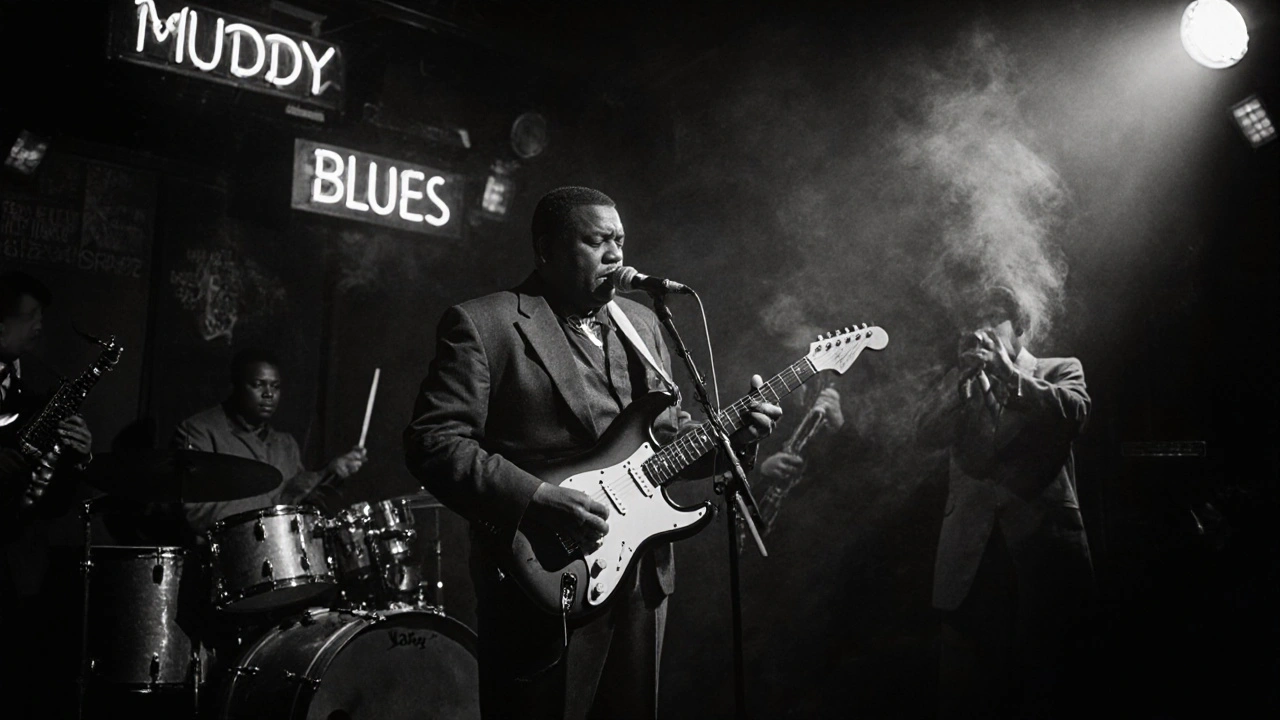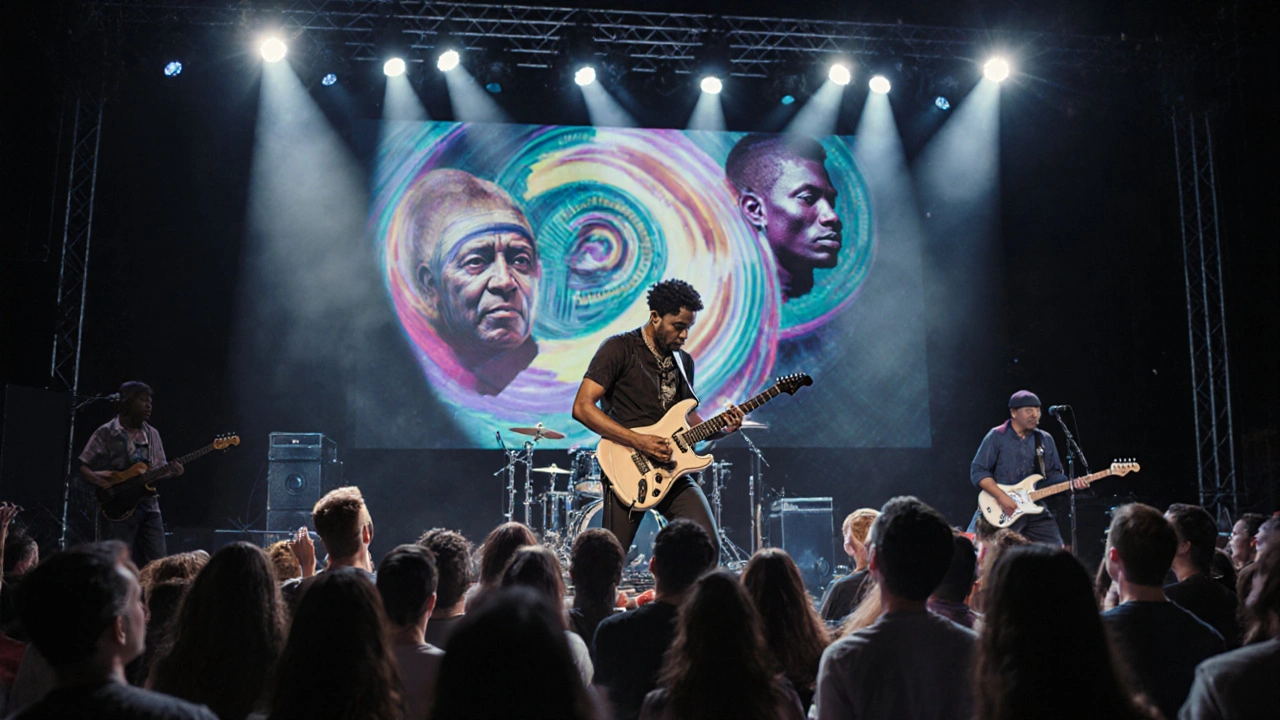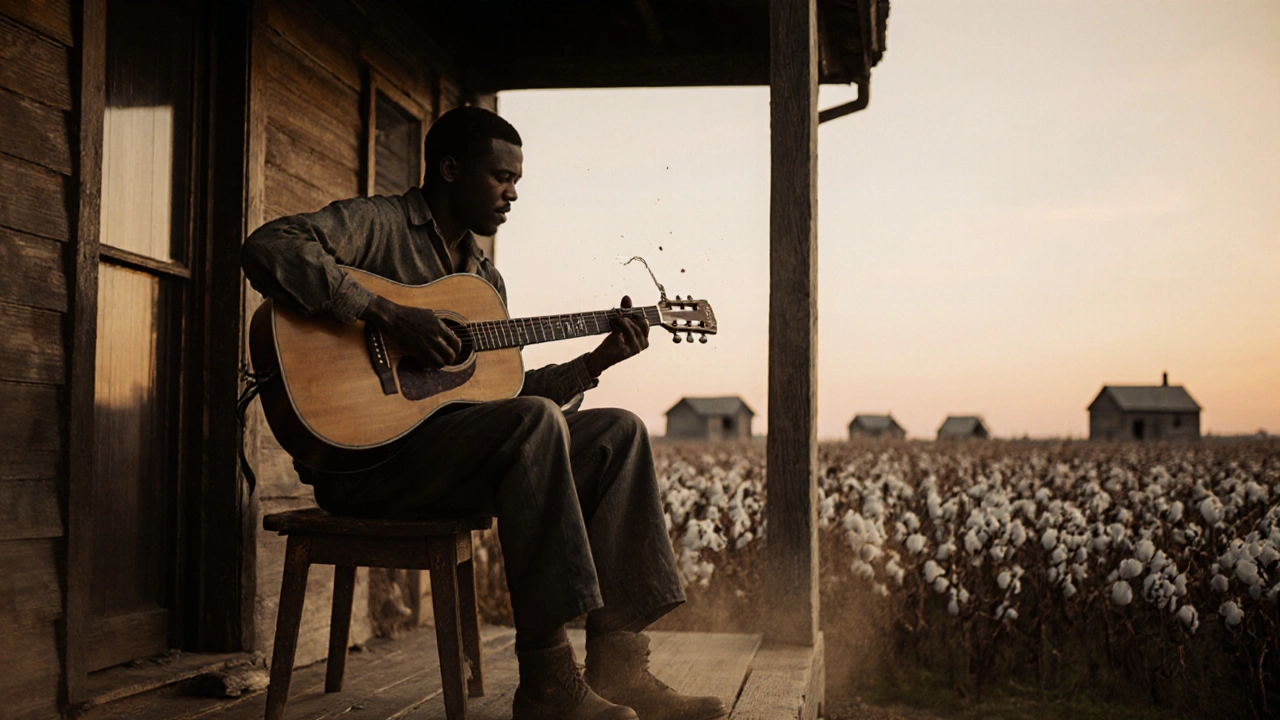12-Bar Blues Generator
The 12-bar blues structure is the backbone of blues music. It's a simple chord pattern that repeats every 12 bars, providing a framework for improvisation and emotional expression. Try generating your own blues progression below.
Select Your Chords
Choose the I, IV, and V chords for your progression
12-Bar Blues Structure
Famous Examples
"Hoochie Coochie Man" by Muddy Waters: Uses G (I), C (IV), D (V) in the key of G
"Cross Road Blues" by Robert Johnson: Uses A (I), D (IV), E (V) in the key of A
"Sweet Home Chicago" by Robert Johnson: Uses C (I), F (IV), G (V) in the key of C
Blues music didn’t start as a genre you’d hear on the radio. It began as a raw, unfiltered cry-songs sung by people who had little else to hold onto. In the late 1800s, African American communities in the Deep South turned pain into rhythm. They didn’t need instruments at first. A hand clapping on a porch, a foot stomping on dirt, a voice cracking with grief or grit-that was blues. It wasn’t written down. It was passed on, changed, and rebuilt with every performance.
Delta Blues: The Roots in the Soil
The earliest form of blues took shape in the Mississippi Delta. This region, with its flat land, cotton fields, and isolated towns, became the birthplace of what we now call Delta blues. Musicians like Charley Patton, Son House, and Robert Johnson played with a raw intensity. They used open tunings, slide guitar, and lyrics that spoke of hard labor, lost love, and spiritual struggle. Johnson’s 1936 recording of “Cross Road Blues” wasn’t just a song-it became a myth. People whispered he sold his soul at a crossroads for that kind of skill.
Delta blues was acoustic, intimate, and often solo. The guitar wasn’t just an instrument-it was an extension of the voice. You could hear the call-and-response pattern from African musical traditions, the bent notes mimicking the human cry, the rhythms that mirrored the pace of fieldwork. There was no studio polish. No backing band. Just one man, his guitar, and the truth he couldn’t say any other way.
Migration and the Birth of Chicago Blues
Between 1916 and 1970, over six million African Americans left the rural South for cities in the North. This Great Migration didn’t just change demographics-it changed music. When people moved to Chicago, Detroit, and St. Louis, they brought their songs with them. But the Delta sound didn’t survive unchanged. It had to adapt.
Chicago in the 1940s was loud. Factories roared. Crowds packed clubs. Acoustic guitars couldn’t compete. So musicians plugged in. Muddy Waters, who had played Delta blues under the stars, picked up an electric guitar in Chicago and turned it into a weapon. He added a bassist, a drummer, and sometimes a harmonica. The result? Chicago blues. It was sharper, faster, and meaner. His 1950 hit “Hoochie Coochie Man” wasn’t just popular-it defined a new sound. The guitar screamed. The drums punched. The lyrics weren’t just about sorrow-they were about survival, swagger, and street wisdom.
Little Walter took the harmonica and made it wail like a siren. Howlin’ Wolf’s voice could shake a building. These weren’t folk singers anymore. They were rock stars before rock existed. And they laid the foundation for everything that came after.

Electric Blues and the Rise of Rock
By the 1950s and 60s, the electric blues sound had crossed racial and cultural lines. White audiences in the U.S. and Europe started listening. British musicians like Eric Clapton, Keith Richards, and Jimmy Page didn’t just like blues-they studied it. They learned from records by B.B. King, Albert King, and Freddie King. They copied licks, borrowed chord progressions, and added distortion.
That’s how blues became rock. The Rolling Stones named themselves after a Muddy Waters song. Led Zeppelin’s “When the Levee Breaks” is built on a John Lee Hooker groove. Cream’s “Crossroads” was a direct cover of Robert Johnson’s original. Blues didn’t disappear-it evolved into something bigger. But it was still there, in every power chord, every bending note, every solo that sounded like a man talking through his instrument.

Modern Blues: Keeping the Flame Alive
Today, blues isn’t just a relic. It’s alive in clubs, festivals, and streaming playlists. Artists like Gary Clark Jr., Fantastic Negrito, and Christone “Kingfish” Ingram are pushing the genre forward. They blend blues with hip-hop beats, punk energy, and soulful vocals. Clark Jr.’s 2019 album “This Land” mixes slide guitar with distorted bass and lyrics about police brutality and identity. It’s blues for 2025-not nostalgia, but protest.
Women, once underrepresented in blues history, are now leading the charge. Shemekia Copeland, Koko Taylor’s protégé, sings with the power of a gospel choir and the grit of a Chicago bar. Larkin Poe, a sister duo from Atlanta, use lap steel and dual vocals to create a modern blues-rock sound that feels both ancient and fresh.
Even the way people consume blues has changed. You can find live recordings from 1935 on YouTube, then switch to a TikTok trend using a B.B. King lick as a background track. Blues isn’t stuck in the past. It’s being remixed, reimagined, and reintroduced to new generations.
Why Blues Still Matters
Blues music isn’t just about chords and scales. It’s about honesty. It’s the sound of people saying, “This hurt, but I’m still here.” That raw emotion is why it still connects. You don’t need to have lived through segregation or sharecropping to feel the weight in a slow 12-bar progression. You just need to have felt loss, anger, or longing.
Modern pop songs still use the blues structure. Think of Adele’s “Someone Like You”-it’s a 12-bar blues with orchestration. Ed Sheeran’s “The A Team” follows the same emotional arc as a classic blues lyric. Even in hip-hop, artists like Kendrick Lamar use blues phrasing in their flows. The DNA is still there.
Blues taught the world how to turn pain into power. It didn’t ask for permission. It didn’t wait to be polished. It just played-and changed everything.
What are the key differences between Delta blues and Chicago blues?
Delta blues is acoustic, solo-driven, and rooted in rural Mississippi. It uses slide guitar, open tunings, and lyrics focused on personal hardship. Chicago blues, by contrast, is electric, band-based, and built for urban clubs. It features amplified guitars, drums, bass, and harmonica, with a more aggressive, rhythmic feel. Delta blues is intimate; Chicago blues is loud.
Who are the most influential blues musicians of all time?
Robert Johnson laid the lyrical and stylistic foundation. Muddy Waters brought blues to the electric age. B.B. King perfected the expressive guitar solo with his vibrato and phrasing. Howlin’ Wolf delivered raw power and charisma. John Lee Hooker created hypnotic, repetitive grooves. These five shaped the sound and spirit of blues across generations.
Is blues music still being made today?
Yes, and it’s evolving. Artists like Gary Clark Jr., Christone "Kingfish" Ingram, and Larkin Poe blend blues with rock, hip-hop, and soul. Festivals like the Chicago Blues Festival and the Mississippi Delta Blues & Heritage Festival draw crowds from all over the world. Blues isn’t dying-it’s adapting, staying relevant by speaking to modern struggles with its timeless language.
How did blues influence rock and roll?
Rock and roll is built on blues. The 12-bar structure, the blue notes, the call-and-response, the guitar solos-all came from blues. Chuck Berry, Elvis Presley, and Little Richard took blues rhythms and added faster tempos and youth culture. British bands like the Rolling Stones and Led Zeppelin directly copied blues licks and turned them into stadium anthems. Without blues, rock wouldn’t have its soul.
Why is the 12-bar blues structure so important?
The 12-bar blues is the backbone of the genre. It’s a simple chord pattern-usually I-IV-V-that repeats every 12 bars. This structure gives musicians a familiar framework to improvise within. It’s easy to learn but deep enough to express complex emotions. Almost every blues song, from B.B. King to modern artists, uses this form. It’s also the foundation for countless rock, R&B, and pop songs.
Blues music didn’t just change-it became the root of modern popular music. From dusty Mississippi roads to global stages, its voice never stopped speaking. And as long as people feel pain, joy, or defiance, it never will.

